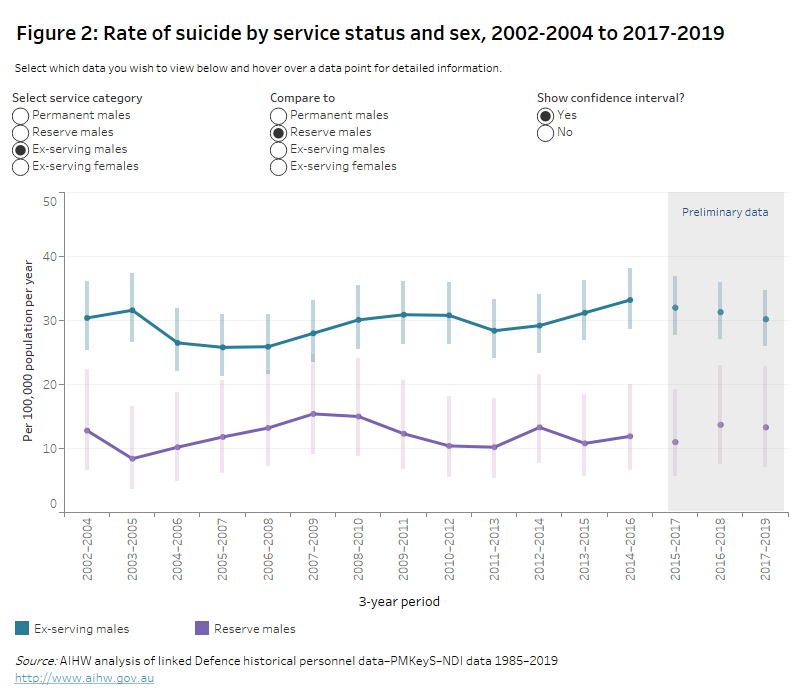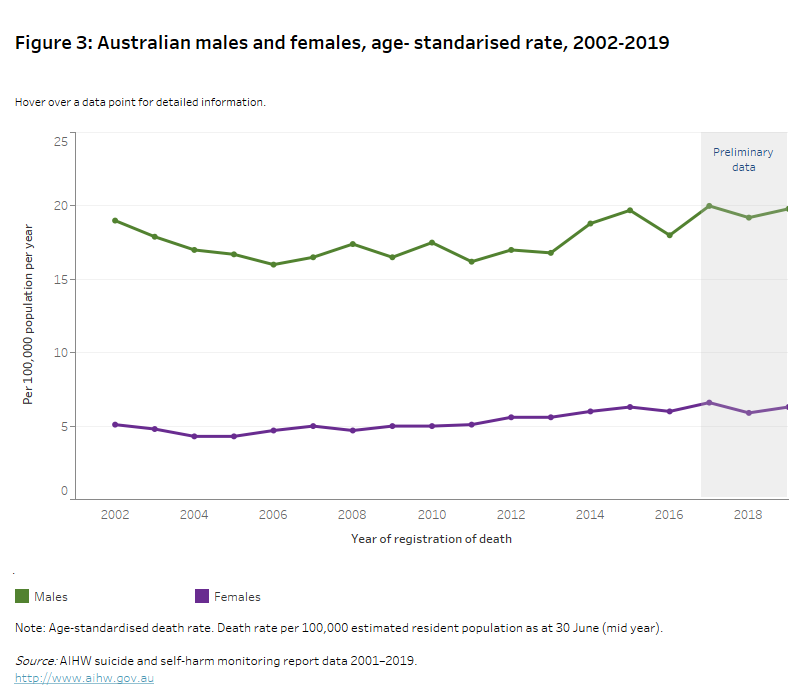Suicides by sex and service status group
On this page:
- Overview
- How do suicide rates vary by service status and sex?
- How many ADF members died by suicide over the study period within each service status group?
- How do suicide rates for permanent, reserve and ex-serving ADF members compare to the general population?
- How have suicide rates changed over time for the different service status groups?
Overview
This section presents suicide rates, age-adjusted suicide rates and numbers of deaths by suicide between 2002 and 2019 broken down by the three service status groups (permanent, reserve and ex-serving). While the absolute number of deaths by suicide has increased since the previous report due to the expansion of the study population to include those who have served since 1985, the suicide rates remain similar. This indicates that the overall patterns in suicide risk remain the same.
How do suicide rates vary by service status and sex?
For those with service since 1985, the suicide rate was highest for ex-serving males. Suicide rates between 2002 and 2019 by service status and sex were as follows:
- 11.3 per 100,000 population per year for permanent males
- 12.5 per 100,000 population per year for reserve males
- 29.8 per 100,000 population per year for ex-serving males
- 14.9 per 100,000 population per year for ex-serving females.
Due to the small number of suicide deaths among females in permanent and reserve service, suicide rates are not reported for these subgroups.
Figure 1: Suicide rate by service status group and sex, 2002–2019
Source: AIHW analysis of linked Defence historical personnel data–PMKeyS–NDI data 1985–2019.
How many ADF members died by suicide over the study period within each service status group?
Between 2001 and 2019 there were 1,273 certified deaths by suicide among members with ADF service since 1 January 1985. Of these, 1,062 (83%) occurred among ex-serving members, 121 among permanent members and 90 among reserves. This is presented in Table 1.
- Number of deaths by suicide from all ADF members are included in the Australian population deaths by suicide count.
Source: AIHW analysis of linked Defence historical personnel data–PMKeyS–NDI data 1985–2019.
AIHW suicide and self-harm monitoring report data 2001–2019.
The number of deaths by suicide for permanent and reserve members combined and ex-serving members, by year, is presented in Table 2. For the number of deaths by suicide for males and females by year see Supplementary table S2.2.
When interpreting Table 2, it is important to remember that the ex-serving population increases each year as described in Box 2. (For population sizes by year see Supplementary tables S8.2 to S8.4)
| Year | Permanent and reserve | Ex-serving | Total in all ADF service groups(a) |
|---|---|---|---|
|
2001 |
18 |
47 |
65 |
|
2002 |
14 |
37 |
51 |
|
2003 |
8 |
51 |
59 |
|
2004 |
12 |
44 |
56 |
|
2005 |
n.p. |
n.p. |
51 |
|
2006(b) |
n.p. |
n.p. |
42 |
|
2007(c) |
11 |
49 |
60 |
|
2008 |
9 |
50 |
59 |
|
2009 |
13 |
46 |
59 |
|
2010 |
13 |
61 |
74 |
|
2011 |
11 |
62 |
73 |
|
2012 |
8 |
53 |
61 |
|
2013 |
12 |
56 |
68 |
|
2014 |
14 |
66 |
80 |
|
2015 |
10 |
71 |
81 |
|
2016 |
15 |
76 |
91 |
|
2017 |
15 |
70 |
85 |
|
2018 |
6 |
68 |
74 |
|
2019 |
11 |
73 |
84 |
|
Total |
211 |
1,062 |
1,273 |
Notes
n.p. Not available for publication but included in totals where applicable, unless otherwise indicated.
- Consists of deaths by suicide in males and females for permanent, reserve and ex-serving ADF members.
- From 2006 onwards, the ABS implemented a revisions process for coroner-certified deaths (such as suicides). This improved data quality by enabling additional deaths by suicide to be identified beyond initial processing (ABS 2018). For detailed information, see Technical notes.
- New ABS coding guidelines were applied for deaths registered from 1 January 2007. The new guidelines improve data quality by enabling deaths to be coded as suicide by ABS mortality coders if evidence indicates the death was from intentional self-harm (ABS 2018). For detailed information, see Technical notes.
Source: AIHW analysis of linked Defence historical personnel data–PMKeyS–NDI data 1985–2019.
How do suicide rates for permanent, reserve and ex-serving ADF members compare to the general population?
After adjusting for age differences (using calculated SMRs to control for differences in age distributions between the ADF and Australian populations), permanent and reserve males had a lower rate of suicide than the general Australian population. However, ex-serving males and females had a higher rate of suicide than the general Australian population.
Due to the small number of suicide deaths among females in permanent and reserve service, suicide rates are not reported for these subgroups.
Compared with the Australian population, suicide rates between 2002 and 2019 were:
- 51% lower for permanent males
- 48% lower for reserve males
- 24% higher for ex-serving males
- 102% (or 2.02 times) higher for ex-serving females.
Unlike suicide rates, these SMRs cannot be used to compare suicide rates between service groups or across time. This is due to the fact that each SMR is a measure that provides a comparison that is specific to the two populations involved, see Technical notes for further detail.
How have suicide rates changed over time for the different service status groups?
This section presents suicide rates over time, in 3-year periods. Due to small numbers, there is some variability in these rates. Over the study period:
- the suicide rate for permanent males remained relatively constant between 7.4 deaths per 100,000 population per year in 2005–2007 and 12.3 in 2017–2019, which was not statistically significant.
- the suicide rate for males in the reserves remained relatively constant between 8.4 deaths per 100,000 population per year in 2003–2005 and 13.3 in 2017–2019, which was not statistically significant.
- the suicide rate for ex-serving males remained relatively constant between 25.8 in 2005–2007 and 33.2 in 2014–2016. In the most recent 3-year period (2017–2019), the rate for this group was 30.2 deaths per 100,000 population per year. These fluctuations were not statistically significant.
- the suicide rate for ex-serving females has remained relatively constant, however due to small numbers has fluctuated between 7.5 in 2003–2005 and 16.0 deaths per 100,000 population per year in 2017–2019, which was not statistically significant.
The rates of suicide for males and females for the Australian general population are presented in the final interactive graph of this section for comparison.
The interactive graph below presents the suicide rates for males in each of the three ADF service status groups and ex-serving females, for all 3-year periods from 2002-2004 to 2017-2019.


Note: The confidence intervals in this figure can be used to determine the significance of differences between the suicide rates calculated for the ADF within a given 3-year period. However, they cannot be used to determine the significance of differences between rates calculated for the ADF population for overlapping 3-year time periods (for example 2002–2004 and 2003–2005).
Data underlying this graph are available in Supplementary tables S3.2,S5.1 and S6.1 See Data for a link to the tables.
Please note, data for more recent years are subject to change: see Technical notes for further detail.
If you need help or support, please contact:
Open Arms - Veterans and Families Counselling 1800 011 046
Open Arms Suicide Intervention page
Defence All-hours Support Line (ASL) 1800 628 036
Defence Member and Family Helpline 1800 624 608
Defence Chaplaincy Support 1300 333 362
Lifeline 13 11 14
Suicide Call Back Service 1300 659 467
Beyond Blue Support Service 1300 22 4636
For information on support provided by DVA, see:


